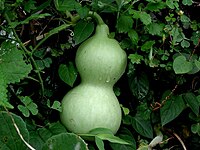
Photo from wikipedia
The natural abundance of Cr and Ni in serpentine soils is well-known, but the food safety of rice grown in these hazardous paddy soils is poorly understood. The study evaluated… Click to show full abstract
The natural abundance of Cr and Ni in serpentine soils is well-known, but the food safety of rice grown in these hazardous paddy soils is poorly understood. The study evaluated the bioaccumulation of chromium (Cr) and nickel (Ni) in rice ( Oryza sativa ) grown in serpentine-derived paddy soils in the Philippines. Surface soil (0–20 cm) samples were collected and characterized across three (i.e., Masinloc, Candelaria, and Sta. Cruz) paddy areas in Luzon Island, Philippines. At least 3 to 4 whole rice plants at mature stage were uprooted manually in each sampling point where the soil samples were collected. The total Cr and Ni concentrations in rice (i.e., roots, shoots, and grains) and soil, soil physicochemical properties, bioaccumulation factor (BAF), translocation factor (TF), and the hazard quotients (HQ) were determined. Results revealed that Cr and Ni in rice were accumulated mostly in the roots. Although paddy soils had elevated total Cr and Ni concentrations, the BAF and soil-to-root TF values for Cr and Ni were < 1. In terms of human health risks, results further revealed low risk for both male and female Filipino adults as HQ values for Cr and Ni were < 1. While it is safe to consume rice grown in the area in terms of Cr and Ni dietary intake, more studies are necessary to understand the dynamics and bioavailability of these heavy metals in other crops and drinking water from tube wells in these areas in order to provide a more holistic human health-based assessments and to ensure consumer safety in serpentine areas. In addition, a more reliable data on Cr and Ni speciation in serpentine soils and crops is critically important. Further studies are also needed to understand the contribution of bioavailable heavy metals in improving the soil health to achieve food safety.
Journal Title: Environmental Science and Pollution Research
Year Published: 2021
Link to full text (if available)
Share on Social Media: Sign Up to like & get
recommendations!